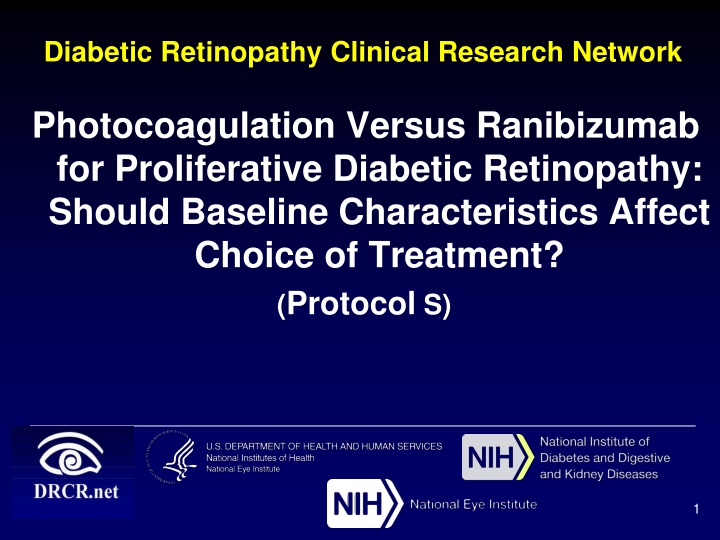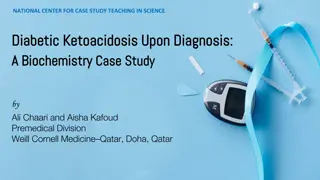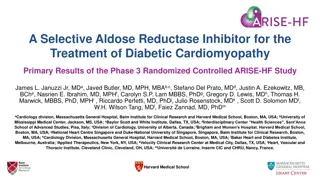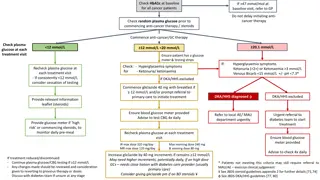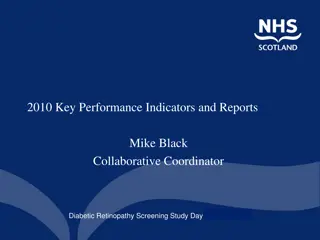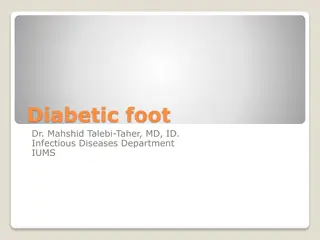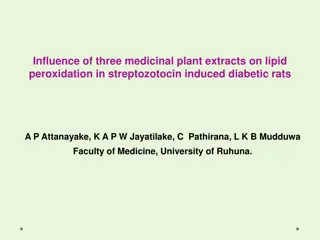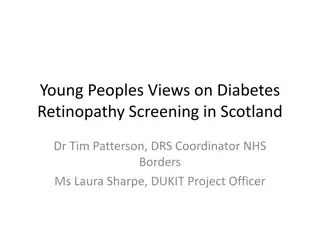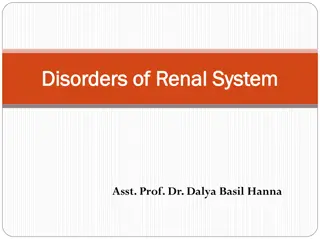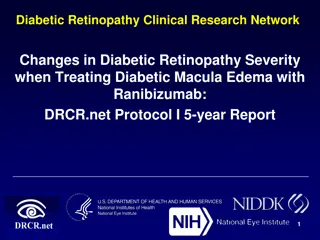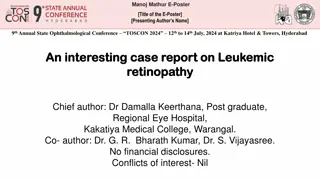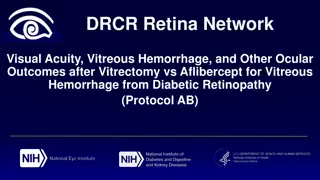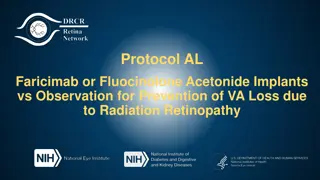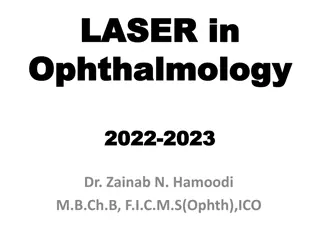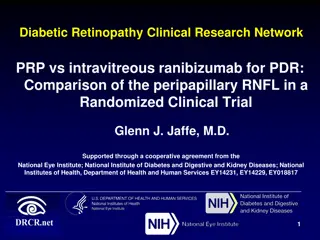Treatment Comparison in Diabetic Retinopathy Research
This study protocol compares the effectiveness of photocoagulation and ranibizumab for proliferative diabetic retinopathy, considering baseline characteristics. The research aims to determine if specific patient traits influence the outcomes of treatment over a two-year period. Various baseline characteristics, including retinal issues, diabetes parameters, age, and previous treatments, will be evaluated for their impact. The study seeks to understand how these factors may alter the benefits of ranibizumab compared to photocoagulation in managing diabetic retinopathy.
Download Presentation

Please find below an Image/Link to download the presentation.
The content on the website is provided AS IS for your information and personal use only. It may not be sold, licensed, or shared on other websites without obtaining consent from the author.If you encounter any issues during the download, it is possible that the publisher has removed the file from their server.
You are allowed to download the files provided on this website for personal or commercial use, subject to the condition that they are used lawfully. All files are the property of their respective owners.
The content on the website is provided AS IS for your information and personal use only. It may not be sold, licensed, or shared on other websites without obtaining consent from the author.
E N D
Presentation Transcript
Diabetic Retinopathy Clinical Research Network Photocoagulation Versus Ranibizumab for Proliferative Diabetic Retinopathy: Should Baseline Characteristics Affect Choice of Treatment? (Protocol S) 1
Background: PRP vs. Anti-VEGF for PDR* For eyes with PDR, change in visual acuity at 2 years with anti-VEGF injections (ranibizumab) was non-inferior (5-letter margin) to panretinal photocoagulation (PRP) +2.2-letter (95% CI: -0.5, +5.0) adjusted difference favoring ranibizumab Ranibizumab resulted in superior change in visual acuity over 2 years (area under the curve) and reduced development of DME 2 *Protocol S Primary Manuscript. JAMA. 2015;314(20)2137-2146
Superiority of Ranibizumab vs. PRP Pre-specified 2 year secondary outcomes as reported in primary paper Ranibizumab Group PRP Group P value Change in VA Over 2 Years (Area Under the Curve) Incident CI-DME + Vision Impairment (20/32 or worse)* +4.5 letters -0.3 letters < .001 9% 28% < .001 3 *Among eyes without CI-DME + vision impairment at baseline (~75% of eyes)
Objectives Explore whether baseline characteristics impact the direction or magnitude of the benefit of ranibizumab over PRP Outcomes: 1. Change in visual acuity over 2 years 2. Development of center-involved DME with vision impairment (20/32 or worse) by 2 years Methods: test for statistical interaction Does the characteristic modify the treatment group difference? 4
25 Baseline Characteristics Evaluated OCT central subfield thickness OCT retinal volume *Epiretinal membrane *Vitreomacular traction *Cystoid abnormalities *Subretinal fluid *Diabetic retinopathy severity on fundus photographs (ETDRS level) *Hemorrhages or microaneurysms *Hard exudates *Surface wrinkling retinopathy Sex Age Race/Ethnicity Diabetes type Diabetes duration HbA1c Mean arterial pressure Hypertension Prior treatment for DME Prior focal/grid laser for DME Prior anti-VEGF for DME Vitreous hemorrhage on clinical exam Visual acuity Lens status (phakic vs. pseudophakic) Neovascularization on clinical exam NVD or NVE only vs. NVD+NVE Lime = Subject-level factor White = Eye-level factor *Graded by reading center Italics indicates continuous variable 5
Change in Vision Over 2 Years 15 Mean Visual Acuity Change Adjusted difference: +4.5 (95% CI: +3.2 to +5.8, P <.001) 10 (Letter Score) 5 +4.5 0 0.0 -5 0 16 32 52 68 84 104 N = 160 Visit Week N = 160 N = 168 N = 168 Ranibizumab Group PRP Group 6
Change in Vision Over 2 Years Participant Characteristics Adjusted Difference* (95% CI) Ran N PRP N Characteristic P value Mean arterial pressure (mmHg)** < 100 (e.g.<140/80) 100 (e.g.>140/80) 88 72 93 75 3.8 (2.0, 5.6) 5.4 (3.4, 7.4) .03 *All analyses were adjusted for baseline vision and OCT central subfield thickness **Numeric variables were analyzed as continuous and dichotomized for tabulation only 7
Change in Vision Over 2 Years Ocular Characteristics Adjusted Difference (95% CI) Ran N PRP N Characteristic P value Prior focal/grid laser treatment for DME No Yes 131 29 143 25 5.1 (3.7, 6.5) 1.0 (-2.3, 4.4) .03 8
Change in Vision Over 2 Years Ocular Characteristics Adjusted Difference (95% CI) Ran N PRP N Characteristic P value Prior focal/grid laser treatment for DME No Yes Neovascularization on clinical exam NVD or NVE only NVD and NVE 131 29 143 25 5.1 (3.7, 6.5) 1.0 (-2.3, 4.4) .03 103 51 107 57 3.6 (1.9, 5.2) 6.7 (4.4, 9.1) .04 9
Change in Vision Over 2 Years Ocular Characteristics Adjusted Difference (95% CI) Ran N PRP N Characteristic P value Prior focal/grid laser treatment for DME No Yes Neovascularization on clinical exam NVD or NVE only NVD and NVE DR severity (ETDRS) Moderate PDR (level 65) or better High-risk PDR (level 71) or worse 131 29 143 25 5.1 (3.7, 6.5) 1.0 (-2.3, 4.4) .03 103 51 107 57 3.6 (1.9, 5.2) 6.7 (4.4, 9.1) .04 99 106 3.8 (2.1, 5.5) .02 59 59 6.1 (3.9, 8.4) 10
Change in Vision Over 2 Years Interaction With DR Severity Level 8 Change in VA Over 2 Years 6 4 +3.8 Letters 2 0 -2 -4 N=99 N=106 N=59 N=59 -6 Moderate PDR or better High-Risk PDR or worse PRP Ranibizumab 11
Change in Vision Over 2 Years Interaction With DR Severity Level 8 Change in VA Over 2 Years Interaction P = .02 6 4 +3.8 Letters +6.1 Letters 2 0 -2 -4 N=99 N=106 N=59 N=59 -6 Moderate PDR or better High-Risk PDR or worse PRP Ranibizumab 12
Summary Change in Vision Over 2 Years No characteristics associated with superiority of PRP over ranibizumab Greater benefit of ranibizumab among participants with higher mean arterial pressure Greater benefit of ranibizumab among eyes without prior focal/grid laser for DME, and more advanced neovascularization Eyes with high-risk PDR had even greater treatment benefit when managed with ranibizumab; this was driven by greater vision loss in the PRP 13
Development of CI-DME with Vision Impairment Eyes without baseline CI-DME and vision impairment Adjusted hazard ratio*: Ranibizumab vs. PRP 0.26 (0.14 to 0.46, P <.001) N = 155 N = 147 14 *<1 indicates benefit of ranibizumab
Development of CI-DME with Vision Impairment Participant Characteristics Adjusted Ran/PRP Hazard Ratio (95% CI)* Ran N PRP N Characteristic P value Race/ethnicity White Non-White 79 67 70 82 0.50 (0.24, 1.03) 0.10 (0.03, 0.30) .01 15 *<1 indicates benefit of ranibizumab
Development of CI-DME with Vision Impairment Participant Characteristics Adjusted Ran/PRP Hazard Ratio (95% CI)* Ran N PRP N P Characteristic value Race/ethnicity White Non-White Mean arterial pressure < 100 mmHg (e.g.<140/80) 100 mmHg (e.g.>140/80) 79 67 70 82 0.50 (0.24, 1.03) 0.10 (0.03, 0.30) .01 84 83 0.39 (0.17, 0.87) .01 63 72 0.16 (0.07, 0.41) 16 *<1 indicates benefit of ranibizumab
Summary Development of CI-DME with Vision Impairment No characteristics associated with superiority of PRP over ranibizumab Greater benefit of ranibizumab in non-white participants, and in participants with higher mean arterial pressure No interactions identified among ocular characteristics 17
Summary Photocoagulation Versus Ranibizumab for Proliferative Diabetic Retinopathy: Should Baseline Characteristics Affect Choice of Treatment? Caution: Due to the large number of statistical comparisons and post hoc design, these results should be viewed as hypothesis-generating and require confirmation in future studies No baseline characteristics were associated with a reversal of our findings: PRP was never superior to ranibizumab for VA area under the curve and incident vision impairing DME Several quantitative interactions were identified suggesting some particiapnts will do even better than others when an anti-VEGF approach is selected may be reasonable alternative to PRP for PDR over 2 years Results provide additional support that ranibizumab 18
Summary Photocoagulation Versus Ranibizumab for Proliferative Diabetic Retinopathy: Should Baseline Characteristics Affect Choice of Treatment? Caution: Due to the large number of statistical comparisons and post hoc design, these results should be viewed as hypothesis-generating and require confirmation in future studies No baseline characteristics were associated with a reversal of our findings: PRP was never superior to ranibizumab for VA area under the curve and incident vision impairing DME Results provide additional support that ranibizumab may be reasonable alternative to PRP for PDR over 2 years, Particularly among those with high blood pressure and more advanced grades of PDR 19
Thank You on Behalf of the Diabetic Retinopathy Clinical Research Network (DRCR.net) 20
